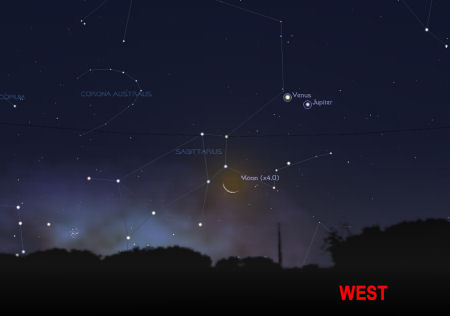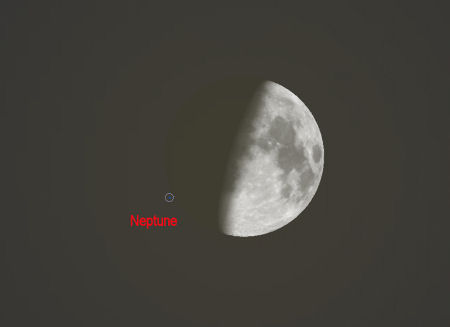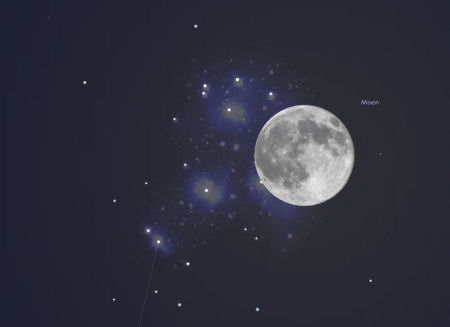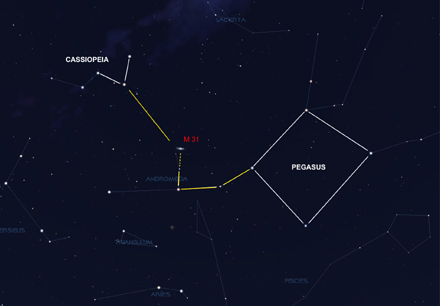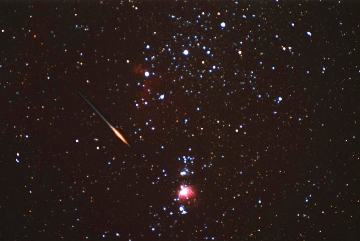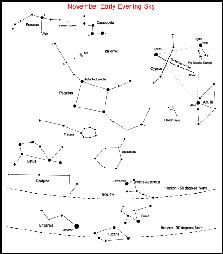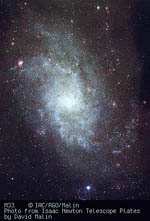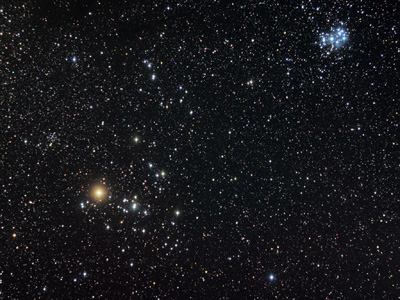The Night Sky November 2008
Compiled by Ian Morison
This page, updated monthly, will let you know some of the things that you can look out for in the night sky. It lists the phases of the Moon, where you will see the naked-eye planets and describes some of the prominent constellations in the night sky during the month.
Image of the Month
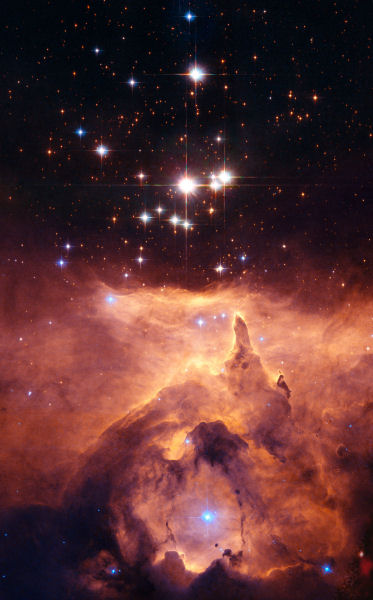
Some of the most massive stars in the Galaxy!
Image: ESA, NASA and J.M. Apellaniz (IAA. Spain)
The open cluster Pismsi 24 that lies above the emission nebula NGC 6357 contains some of the most massive and brightest stars that we know of in our Milky Way Galaxy. What appears to be a single bright star in the centre of the cluster is now believed to made up of at least three stars whose masses would be ~100 solar masses. Such stars have very short lives before producing spectacular supernova explosions! More stars are forming within the nebula below.
Highlights of the Month
November 30th: Jupiter, Venus and a waxing crescent Moon
Jupiter and Venus come to within 2 degrees of each other on November 30th and will be seen above and to the right of a thin waxing crescent Moon. This will surely be one of the most beautiful skyscapes visible this month. let us hope that it is clear!
November 6th: Occultation of Neptune by the Moon
If you lie above an imaginary line from the Lizard Peninsular through York and up the top of the North Yorkshire Moors, you have a chance to observe an occultation of Neptune by the Moon just after first quarter. it will take place between ~18:00 to 19:30 (dependent on your location). If you actually lie along the line described above then you may see what is called a grazing occultation when Neptune will blink in and out as its light passes through the mountains and valleys of the Moon.
November 13th: Occultation of the Pleiades Cluster by the Moon
During the early evening of the 13th November,the Moon will pass in front of the Pleiades Cluster. Sadly, the Moon is full so the cluster stars will not be too well seen, but it could still be worth observing with binoculars or a small telescope.
Find M31 - The Andromeda Galaxy
In the evening, the galaxy M31 in Andromeda is visible in the south. The chart above provided two ways of finding it:
1) Find the square of Pegasus. Start at the top left star of the square - Alpha Andromedae - and move two stars to the left and up a bit. Then turn 90 degrees to the right, move up to one resonably bright star and continue a similar distance again in the same direction. You should easily spot M31 with binoculars and, if there is a dark sky, you can even see it with your unaided eye. The photons that are falling on your retina left Andromeda well over two million years ago!
2) You can also find M31 by following the "arrow" made by the three rightmost bright stars of Cassiopeia down to the lower right as shown on the Chart. Good Hunting!
November: The Leonids and Taurids Meteor Showers
Every year, on November 17th and 18th, the Earth passed close to the trails of cometry debris from Comet Temple-Tuttle which produce the annual Leonid Meteor shower. The wonderful image above shows one of the 2001 Leonids burning up in the atmosphere as it crossed the constellation of Orion. Sadly, this year, the Moon will be close to the radiant and near full Moon, so our chances of seeing them will not be good. It is expected that only 12 to 15 meteors are likely per hour, but they do tend to be bright so it is just worth a try. The dust particles that are swept up by the Earth are released as Comet Temple-Tuttle rounds the Sun every 33 years.
We may have more luck with the Taurids. There are two showers: the northern Taurids peak around the 4th to the 7th November whilst the southern Taurids peak from the 30th October to the 7th November. The Moon will be setting in the evening during the first week of November, so the chances of observing them are quite good - and some could well be very bright as observed in 2005. Perhaps after the bonfire night celebrations you might see some celestial fireworks!
Observe the International Space Station

The International Space Station and Jules Verne passing behind the Lovell Telescope on April 1st 2008.
Image by Andrew Greenwood
Use the link below to find when the space station will be visible in the next few days. In general, the space station can be seen either in the hour or so before dawn or the hour or so after sunset - this is because it is dark and yet the Sun is not too far below the horizon so that it can light up the space station. As the orbit only just gets up the the latitude of the UK it will usually be seen to the south, and is only visible for a minute or so at each sighting. Note that as it is in low-earth orbit the sighting details vary quite considerably across the UK. The NASA website linked to below gives details for several cities in the UK. (Across the world too for foreign visitors to this web page.)
Note: I observed the ISS three times in the last week or so of July and was amazed as to how bright it has become.
Find details of sighting possibilities from your location from: Location Index
See where the space station is now: Current Position
The Moon

The Moon at 3rd Quarter. Image, by Ian Morison, taken with a 150mm Maksutov-Newtonian and Canon G7.
Just below the crator Plato seen near the top of the image is the mountain "Mons Piton". It casts a long shadow across the maria from which one can calculate its height - about 6800ft or 2250m.
| new | first quarter | full moon | last quarter |
|---|---|---|---|
| November 27th | November 6th | November 13th | November 20th |
Some Lunar Images by Ian Morison, Jodrell Bank Observatory: Lunar Images
The Planets
Jupiter
Jupiter is seen low down in the south-west as nightfall begins. It lies above the "teapot" in Sagittarius. It begins Nevember with an angular size of 37 arc seconds which slowly reduces as the month progresses. In like manner, its brightness slowly reduces from -2.2 magnitudes during the month.
Jupiter is now at the lowest point of the ecliptic in the sky and will only be seen about 10-12 degrees elevation above the horizon at nightfall. Thus, sadly, this year our views of Jupiter from northern latitudes have been rather poor. Despite the low elevation, even a small telescope will show the Galilean Moons as they weave their way around it. Due to refraction, we see Jupiter at very slightly different elevations in the different colours of the spectrum, thus bluring the image. A cleaner image may seen if one observes through a narrow band filter such as a green filter or, even better, if you have an 8" scope or above with a filter like an OIII filter only letting a very narrow band of light through.
See the highlight above relating to its conjunction with Venus at the end of the month!
Saturn
Saturn is now visible in the pre-dawn sky and is seen higher as the month progresses. It will be best seen at the end of the month at ~05:40 UT when has reached an elevation of ~40 degrees before the Sun rises. It has a magnitude of ~+1 throughout the month. This is significantly less than it often appears as the rings will then be at an angle of just 4 degrees from edge on! As we move towards into next year, this angle will reduce until the rings are edge on and become invisible to us. Saturn is close to the thin crescent Moon on the 21st and 22nd of November.
Mercury
Mercury: passeed between us and the Sun on the 6th of October, but soon re-appeared in the pre-dawn sky to reaches western elongation (when it is furthest from the Sun) on 22nd of the October lying in the constellation Virgo. At the beginning of November it can still be seen just after 06:00 UT low in the east-southeast. At magnitude -0.8 binoculars should be able to pick it out during the first seven days of November before it is lost in the glare of the Sun.
Mars
Mars lies so close to the Sun this month that it cannot be observed.
Venus
Venus can be seen very low in the west after sunset shining at magnitude -3.9 so it is possible to spot it without the use of binoculars. It is gradually moving further in angle from the Sun so will remain in the evening sky for longer after the Sun has set as the month progresses whilst its brightness increases fractionally to a magnitude of -4. It starts November with an angular size of 13.3 arc seconds. By the end of the month, the angular size has increased to 16 arc seconds, but the percentage illuminated will have dropped. These two effects tend to cancel out in the way they affect its apparent brightness which is why the brightness remains almost constant. At the beginning of November it is only a few degrees aboved the horizon when seen after sunset but, as the month progresses it will be seen higher in the sky - just in time for its conjunction with Jupiter! See highlight above.
Find more planetary images and details about the Solar System: The Solar System
The Stars
The Evening November Sky
This map shows the constellations seen towards the south in early evening. To the south in early evening moving over to the west as the night progresses is the beautiful region of the Milky Way containing both Cygnus and Lyra. Below is Aquilla. The three bright stars Deneb (in Cygnus), Vega (in Lyra) and Altair (in Aquila) make up the "Summer Triangle". East of Cygnus is the great square of Pegasus - adjacent to Andromeda in which lies M31, the Andromeda Nebula. To the north lies "w" shaped Cassiopeia and Perseus. The constellation Taurus, with its two lovely clusters, the Hyades and Pleiades is rising in the east during the late evening.
The constellations Lyra and Cygnus
This month the constellations Lyra and Cygnus are seen almost overhead as darkness falls with their bright stars Vega, in Lyra, and Deneb, in Cygnus, making up the "summer triangle" of bright stars with Altair in the constellation Aquila below. (see sky chart above)
Lyra
Lyra is dominated by its brightest star Vega, the fifth brightest star in the sky. It is a blue-white star having a magnitude of 0.03, and lies 26 light years away. It weighs three times more than the Sun and is about 50 times brighter. It is thus burning up its nuclear fuel at a greater rate than the Sun and so will shine for a correspondingly shorter time. Vega is much younger than the Sun, perhaps only a few hundred million years old, and is surrounded by a cold,dark disc of dust in which an embryonic solar system is being formed!
There is a lovely double star called Epsilon Lyrae up and to the left of Vega. A pair of binoculars will show them up easily - you might even see them both with your unaided eye. In fact a telescope, provided the atmosphere is calm, shows that each of the two stars that you can see is a double star as well so it is called the double double!
Between Beta and Gamma Lyra lies a beautiful object called the Ring Nebula. It is the 57th object in the Messier Catalogue and so is also called M57. Such objects are called planetary nebulae as in a telescope they show a disc, rather like a planet. But in fact they are the remnants of stars, similar to our Sun, that have come to the end of their life and have blown off a shell of dust and gas around them. The Ring Nebula looks like a greenish smoke ring in a small telescope, but is not as impressive as it is shown in photographs in which you can also see the faint central "white dwarf" star which is the core of the original star which has collapsed down to about the size of the Earth. Still very hot this shines with a blue-white colour, but is cooling down and will eventually become dark and invisible - a "black dwarf"! Do click on the image below to see the large version - its wonderful!
M56 is an 8th magnitude Globular Cluster visible in binoculars roughly half way between Alberio (the head of the Swan) and Gamma Lyrae. It is 33,000 light years away and has a diameter of about 60 light years. It was first seen by Charles Messier in 1779 and became the 56th entry into his catalogue.
Cygnus
Cygnus, the Swan, is sometimes called the "Northern Cross" as it has a distinctive cross shape, but we normally think of it as a flying Swan. Deneb,the arabic word for "tail", is a 1.3 magnitude star which marks the tail of the swan. It is nearly 2000 light years away and appears so bright only because it gives out around 80,000 times as much light as our Sun. In fact if Deneb where as close as the brightest star in the northern sky, Sirius, it would appear as brilliant as the half moon and the sky would never be really dark when it was above the horizon!
The star, Albireo, which marks the head of the Swan is much fainter, but a beautiful sight in a small telescope. This shows that Albireo is made of two stars, amber and blue-green, which provide a wonderful colour contrast. With magnitudes 3.1 and 5.1 they are regarded as the most beautiful double star that can be seen in the sky.
Cygnus lies along the line of the Milky Way, the disk of our own Galaxy, and provides a wealth of stars and clusters to observe. Just to the left of the line joining Deneb and Sadr, the star at the centre of the outstretched wings, you may, under very clear dark skys, see a region which is darker than the surroundings. This is called the Cygnus Rift and is caused by the obscuration of light from distant stars by a lane of dust in our local spiral arm. the dust comes from elements such as carbon which have been built up in stars and ejected into space in explosions that give rise to objects such as the planetary nebula M57 described above.
There is a beautiful region of nebulosity up and to the left of Deneb which is visible with binoculars in a very dark and clear sky. Photographs show an outline that looks like North America - hence its name the North America Nebula. Just to its right is a less bright region that looks like a Pelican, with a long beak and dark eye, so not surprisingly this is called the Pelican Nebula. The photograph below shows them well.
Brocchi's Cluster An easy object to spot with binoculars in Gygnus is "Brocchi's Cluster", often called "The Coathanger",although it appears upside down in the sky! Follow down the neck of the swan to the star Alberio, then sweep down and to its lower left. You should easily spot it against the dark dust lane behind.
The constellations Pegasus and Andromeda
Pegasus
The Square of Pegasus is in the south during the evening and forms the body of the winged horse. The square is marked by 4 stars of 2nd and 3rd magnitude, with the top left hand one actually forming part of the constellation Andromeda. The sides of the square are almost 15 degrees across, about the width of a clentched fist, but it contains few stars visibe to the naked eye. If you can see 5 then you know that the sky is both dark and transparent! Three stars drop down to the right of the bottom right hand corner of the square marked by Alpha Pegasi, Markab. A brighter star Epsilon Pegasi is then a little up to the right, at 2nd magnitude the brightest star in this part of the sky. A little further up and to the right is the Globular Cluster M15. It is just too faint to be seen with the naked eye, but binoculars show it clearly as a fuzzy patch of light just to the right of a 6th magnitude star.
Andromeda
The stars of Andromeda arc up and to the left of the top left star of the square, Sirra or Alpha Andromedae. The most dramatic object in this constellation is M31, the Andromeda Nebula. It is a great spiral galaxy, similar to, but somewhat larger than, our galaxy and lies about 2.5 million light years from us. It can be seen with the naked eye as a faint elliptical glow as long as the sky is reasonably clear and dark. Move up and to the left two stars from Sirra, these are Pi amd Mu Andromedae. Then move your view through a rightangle to the right of Mu by about one field of view of a pair of binoculars and you should be able to see it easily. M31 contains about twice as many stars as our own galaxy, the Milky Way, and together they are the two largest members of our own Local Group of about 3 dozen galaxies.
M33 in Triangulum
If, using something like 8 by 40 binoculars, you have seen M31 as described above, it might well be worth searching for M33 in Triangulum. Triangulum is
the small faint constellation just below Andromeda. Start on M31, drop down to Mu Andromedae and keep on going in the same direction by the same distance as you have moved from M31 to Mu Andromedae. Under excellent seeing conditions (ie., very dark and clear skies) you should be able to see what looks like a little piece of tissue paper stuck on the sky or a faint cloud. It appears to have uniform brightness and shows no structure. The shape is irregular in outline - by no means oval in shape and covers an area about twice the size of the Moon. It is said that it is just visible to the unaided eye, so it the most distant object in the Universe that the eye can see. The distance is now thought to be 3.0 Million light years - just greater than that of M31.
The constellation Taurus
Taurus is one of the most beautiful constellations and you can almost imagine the Bull charging down to the left towards Orion. His face is delineated by the "V" shaped cluster of stars called the Hyades, his eye is the red giant star Aldebaran and the tips of his horns are shown by the stars beta and zeta Tauri. Although alpha Tauri, Aldebaran, appears to lie amongst the stars of the Hyades cluster it is, in fact, less than half their distance lying 68 light years away from us. It is around 40 times the diameter of our Sun and 100 times as bright.
More beautiful images by Alson Wong : Astrophotography by Alson Wong
To the upper right of Taurus lies the open cluster, M45, the Pleiades. Often called the Seven Sisters, it is one of the brightest and closest open clusters. The Pleiades cluster lies at a distance of 400 light years and contains over 3000 stars. The cluster, which is about 13 light years across, is moving towards the star Betelgeuse in Orion. Surrounding the brightest stars are seen blue reflection nebulae caused by reflected light from many small carbon grains. These relfection nebulae look blue as the dust grains scatter blue light more efficiently than red. The grains form part of a molecular cloud through which the cluster is currently passing. (Or, to be more precise, did 400 years ago!)
Close to the tip of the left hand horn lies the Crab Nebula, also called M1 as it is the first entry of Charles Messier's catalogue of nebulous objects. Lying 6500 light years from the Sun, it is the remains of a giant star that was seen to explode as a supernova in the year 1056. It may just be glimpsed with binoculars on a very clear dark night and a telescope will show it as a misty blur of light.
Its name "The Crab Nebula" was given to it by the Third Earl of Rosse who observed it with the 72 inch reflector at Birr Castle in County Offaly in central Ireland. As shown in the drawing above, it appeared to him rather lile a spider crab. The 72 inch was the world's largest telelescope for many years. At the heart of the Crab Nebula is a neutron star, the result of the collapse of the original star's core. Although only around 20 km in diameter it weighs more than our Sun and is spinning 30 times a second. Its rotating magnetic field generate beams of light and radio waves which sweep across the sky. As a result, a radio telescope will pick up very regular pulses of radiation and the object is thus also known a Pulsar. Its pulses are monitored each day at Jodrell Bank with a 13m radio telescope.


